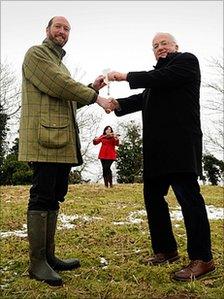Fiddler's Hill: Norfolk Archaeological Trust takes over monument
- Published

The mound was named after a fiddler disappeared while seeking ghosts
The future of one of Norfolk's best-preserved ancient burial mounds has been placed into the hands of a local heritage group.
Fiddler's Hill, between Binham and Warham, has been transferred from Norfolk County Council to the Norfolk Archaeological Trust (NAT).
The deal is expected to lead to improved public access and historic interpretation on the bronze age site.
The NAT said the 4,000-year-old hill is a welcome addition to their sites.
"This adds an important prehistoric site to our existing portfolio which includes Caistor Roman town, Burgh Castle and St Benet's Abbey," said NAT chairman Matthew Martin.
The mound was given its name when a fiddler decided to investigate tales about the ghost of a monk that was said to emerge each night from a tunnel running between Binham and Walsingham.
As he walked into the tunnel with his dog he played his fiddle so the villagers could hear his progress, but when he reached the mound the music stopped.
Although the dog emerged from the tunnel shivering and whining, the fiddler was never seen again.